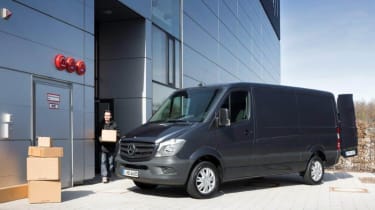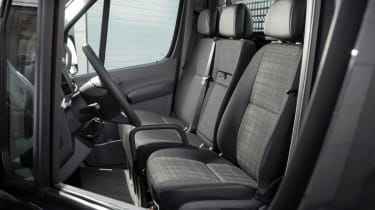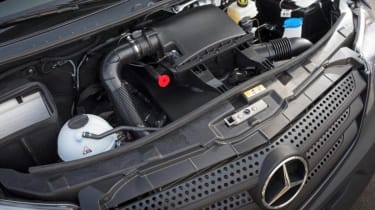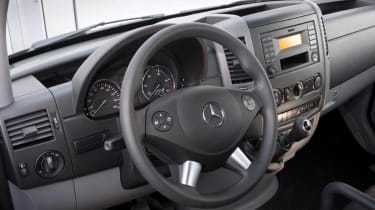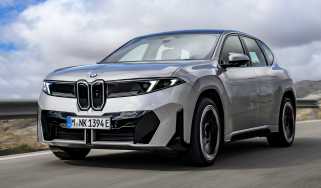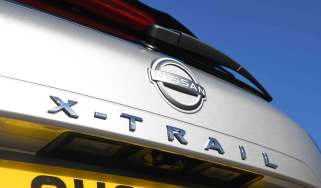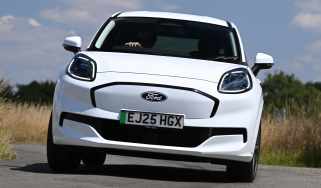Mercedes Sprinter (2008-2018) van review
The Mercedes Sprinter brings a premium feel to the large van market and it’s available in nine bodystyles
The Mercedes Sprinter has been around since 1995, and the current Mk2 has been on sale since 2006. The Sprinter offers the practicality of a boxy panel van but with that much-beloved three-pointed star on the front. It's a recipe that's worked well for the company, and the Sprinter name is almost as well regarded as 'Transit' in the commercial vehicle world.
The Sprinter comes with a choice of nine bodystyles. There's a standard Panel Van, Traveliner minibus, a dropside pickup and the adaptable chassis cab, which can be anything from a Luton van to a coachbuilt motorhome. Each is available in a range of different body lengths and heights, and payloads vary accordingly. Power comes from four and six-cylinder CDI common-rail diesel engines.
The 2.2-litre four-cylinder delivers 95bhp, 129bhp or 163bhp, while the 3.0-litre V6 puts out 190bhp. There's also the option of a 156bhp bi-fuel engine, powered by compressed natural gas and petrol. All versions come with a six-speed ECO Gear manual gearbox as standard, although Mercedes is one of the few van manufacturers to offer a full automatic. The 7GTronic seven-speed box is available on most versions of the Sprinter, and is the same set-up found in Mercedes cars of the same era, so it's smooth and fast-shifting compared to some van rivals.
Used - available now

2024 Jaguar
XE
18,875 milesAutomaticPetrol2.0L
Cash £30,750
2024 Peugeot
2008
8,324 milesAutomaticPetrol1.2L
Cash £18,949
2023 Peugeot
208
16,870 milesAutomaticPetrol1.2L
Cash £15,349
2024 Cupra
Formentor
21,526 milesAutomaticPetrol1.5L
Cash £22,149Whether you go for the auto or manual box, power is sent to the rear wheels on every Sprinter, while a 4x4 four-wheel-drive system is optional on all but the smallest models.
Despite being on sale for more than a decade, the Sprinter still posted strong sales in its final year (2017). The new Sprinter arrives in 2018, and promises to add advanced connectivity to the current van's excellent load carrying versatility.
Rivals for the Sprinter are the Volkswagen Crafter (the Mk1 was essentially a rebadged Sprinter, but the Mk2 is an in-house VW product, which is also sold as the MAN TGE), Ford Transit, Iveco Daily, Citroen Relay/Peugeot Boxer/Fiat Ducato trio and the Renault Master/Vauxhall Movano/Nissan NV400 family of large vans.
MPG, CO2 and Running Costs
All versions of the Sprinter get the Mercedes BlueEFFICIENCY package of eco tweaks. This brings stop-start, which cuts the engine as you select netural when the van is stopped, then restarts it when you depress the clutch, or lift off the brake pedal in automatic models. Also included is a low-energy power-steering pump, plus you get a gearshift indicator in the dash to signal when to change gear to minimise fuel consumption.
Low-rolling-resistance tyres have the same effect, as does the tuned management of the alternator and battery. Smaller rear-wheel-drive Sprinters with BlueEFFICIENCY are capable of up to 35.3mpg and CO2 emissions as low as 195g/km – although the VW Crafter, which shares the same basic body, claims better mpg. Most versions of the Sprinter sit in insurance group 8A, while Mercedes’ optional ASSYST variable service system takes care of the service intervals, and allows oil changes of up to 31,000 miles or every two years.
A big bonus for owners is that the Sprinter is sold through Mercedes truck dealerships. These provide extended and, in some cases, 24-hour service and repair, so you can have your van looked at overnight and not have to lose a day’s business. Iveco and selected Renault dealers offer a similar service.
Load Space and Practicality
There’s a Sprinter to suit most large van jobs, with nine body sizes on three wheelbases, plus four body lengths and three roof heights. The van is particularly popular with couriers and home delivery companies, and Mercedes’ three-pointed star badge still adds presence for businesses keen to present a professional image. The Sprinter is also frequently used by the ambulance service, and is a common choice for camper conversions. Most models can be specified with double cabs, offering a second row of seating.
Rear-wheel drive is standard, but Mercedes offers a high-riding four-wheel-drive option for buyers who require off-road performance. These 4x4 models get low-ratio gearing, and the system uses clever 4ETS electronic traction control to automatically send drive to the wheels with the most grip. The downside of having drive going to the rear on all versions of the Sprinter is that the floor has to be slightly higher than on front-wheel-drive competitors, like the VW Crafter and Renault Master. This doesn’t eat into load capacity too much, though – the largest Sprinter models make great use of their LWB dimensions to claim 17 cubic metres of space. That’s right up there with the best rear-drive panel vans on the market, like the Iveco Daily, VW Crafter and Vauxhall Movano.
A towing capacity of up to 2,000kg adds to the appeal of the Sprinter, while the adaptive ESP stability system fitted as standard on all models includes trailer stability assist – this helps the driver to counteract van and trailer sway.
Don’t get confused by Mercedes’ baffling model names, as it’s fairly easy to decipher. Take the 313 CDI as an example: the 3 refers to the gross vehicle weight (three tonnes-plus), while the 13 refers to the engine’s power output, of around 130bhp. The fact Mercedes no longer sells the 311 CDI, with a near-identical engine, has helped to clarify things.
Reliability and Safety
Mercedes has a fine reputation for the durability of its vans, and was ranked among the top three for reliability, alongside Volkswagen and Ford. There have been a few minor engine issues and reports of body corrosion, but you only have to look at how many long-distance and multi-drop couriers use the Sprinter to see that the vans can take the miles. Some operators may be wary of a rear-wheel-drive van, especially if their drivers aren’t especially experienced, but Mercedes includes a raft of standard safety technology – from adaptive ESP and acceleration skid control (ASR) to brake assist (BAS) and ESP trailer stabilisation – to assist the driver.
In fact, the company was one of the first manufacturers to offer ESP as standard on all its vans. Another useful safety feature is the adaptive brake lights, which flash in the event of harsh braking to warn drivers behind. There’s also a wide range of safety options on the Sprinter, with everything from bi-xenon headlights and rain sensors with headlamp assist, to tyre pressure monitoring and multiple airbags.
The Sprinter has a full-width bulkhead to protect driver and passengers if a load moves in the event of an accident. And while every van gets load securing rings in the cargo floor, the Sprinter stands out by also offering optional lashing rings on the belt rail at half height, and just beneath the roof rail if required.
Driving and Performance
One of the most powerful engines on the van market is available in the Mercedes Sprinter, in the shape of the 190bhp 3.0-litre V6 CDI diesel. It just trails the 3.0-litre twin-turbodiesel in the Iveco Daily, which delivers 205bhp, and also has the edge on torque, with 470Nm to the Sprinter V6’s 440Nm.
Still, the Mercedes engine is a strong performer, and even the smaller 2.2-litre four-cylinder diesels provide adequate grunt for hauling loads around at motorway speeds. You sit as high in the Sprinter as in the Volkswagen Crafter and Renault Master, and get a similarly good view of the road. Plus, the van rides well, whether it’s empty or fully loaded.
Buyers opting for the automatic transmission will find the Sprinter really easy to drive around town, leaving both hands free to position the van in traffic. Iveco offers an automated manual gearbox in the Daily, while Fiat has an automatic transmission in the most powerful Ducato. For those who need real go-anywhere ability, the 4x4 Sprinter provides exceptional off-road performance – it’s much more capable over challenging terrain than the AWD version of the Ford Transit, for example, and a match for the Iveco Daily 4x4. The extra ride height and clever traction control system allow the Sprinter to get to inaccessible locations.
Cab and Interior
The well laid out cab in the Sprinter features durable plastics and fabrics, and should cope with the strains of daily use – although the Renault Master and Vauxhall Movano have more internal storage options. The single stalk for the indicators, wipers and main-beam headlights will be familiar to anyone who has driven a Mercedes car, but can take a few minutes to get to grips with if you’re not used to it.
The stubby gearlever on manual models is within easy reach of the steering wheel, allowing reasonable cross-cab access, if not as easy as in the front-wheel-drive Fiat Ducato and Citroen Relay. Still, the view from the cab is good, while additional wide angle door mirrors are standard, to cover blind spots. As it’s a Mercedes, there’s a host of options, from Bluetooth connectivity and COMAND sat-nav to rear parking cameras and cruise control. But the price will soon spiral if you start adding these extras.
Van dimensions
| Body style | Height | Width | Length |
| SWB standard roof van | 2,435mm | 2,426mm | 5,245mm |
| SWB high roof van | 2,720mm | 2,426mm | 5,245mm |
| MWB standard roof van | 2,530mm | 2,426mm | 5,910mm |
| MWB high roof van | 2,820mm | 2,426mm | 5,910mm |
| MWB super-high roof van | 3,050mm | 2,426mm | 5,910mm |
| LWB high roof van | 2,815mm | 2,426mm | 6,945mm |
| LWB super-high roof van | 3,045mm | 2,426mm | 6,945mm |
| XLWB high roof van | 2,820mm | 2,426mm | 7,345mm |
| XLWB super-high roof van | 3,055mm | 2,426mm | 7,345mm |
(Van body width is 1,993mm, rising to 2,426mm if including mirrors)
Load area dimensions
| Body style | Height | Width | Length | Volume |
| SWB standard roof van | 1,650mm | 1,780mm | 2,600mm | 7.5m3 |
| SWB high roof van | 1,940mm | 1,780mm | 2,600mm | 8.5m3 |
| MWB standard roof van | 1,650mm | 1,780mm | 3,265mm | 9.0m3 |
| MWB high roof van | 1,940mm | 1,780mm | 3,265mm | 10.5m3 |
| MWB super-high roof van | 2,140mm | 1,780mm | 3,265mm | 11.5m3 |
| LWB high roof van | 1,940mm | 1,780mm | 4,300mm | 14.0m3 |
| LWB super-high roof van | 2,140mm | 1,780mm | 4,300mm | 15.5m3 |
| XLWB high roof van | 1,940mm | 1,780mm | 4,700mm | 15.5m3 |
| XLWB super-high roof van | 2,140mm | 1,780mm | 4,700mm | 17.0m3 |
(Maximum width figure of 1,780mm. This is reduced to 1,350mm between wheel arches)

